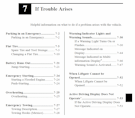Land Rover back-up start After updating Land Rover back-up start procedures it was clear that the company needed its own page. That page is now up. Jaguar gets to keep the original. When we first made the page, the sister companies shared nearly identical procedures, back up start locations and key fobs. Over time, those …
Tag: Jaguar
Permanent link to this article: https://dashboardsymbols.com/2025/03/we-have-finished-our-jaguar-symbols-update/
Permanent link to this article: https://dashboardsymbols.com/2025/03/a-new-separate-land-rover-back-up-start-page-is-up-at-the-site/
Jaguar back-up start option reveals three model changes
Jaguar back-up start An update of Jaguar back-up start locations finds changes in three models: the XE, XF, and F-Pace. All the changes came in 2020 and 2021 — its been too long since we updated! If you’re wondering, back-up start locations are made necessary when the battery in the key fob is depleted, which …
Permanent link to this article: https://dashboardsymbols.com/2025/03/jaguar-back-up-start-option-reveals-three-model-changes/
Jaguar back-up entry review turns up one addition
Jaguar back-up entry After the Land Rover entry update, we shifted to update the sister company Jaguar back-up entry. The two companies currently share a page, but it reads poorly and they will need to be separated. In any case, we found a single change involving the F-Type, and its something we had evidently simply …
Permanent link to this article: https://dashboardsymbols.com/2025/03/jaguar-back-up-entry-review-turns-up-one-addition/
Jaguar symbols page now sports the color re-set
Jaguar symbols As we continue an update of Land Rover back-up entry and start processes as well as its dashboard symbols page, we have re-ordered sister company Jaguar symbols page by color. That’s now 45 of our 49 symbols pages re-set, and it sure is tempting to polish them all off. We expect that what …
Permanent link to this article: https://dashboardsymbols.com/2025/03/jaguar-symbols-page-now-sports-the-color-re-set/
Jaguar Dashboard Symbols and Warning Lights
Jaguar Symbols So, what is that light on your dashboard? What follows is easily the most complete list available of symbols and warnings that may appear in and on your Jaguar’s dashboard or instrument panel. The following are warning lights and indicators found in vehicles built by Jaguar. Click the link to the right of …
Permanent link to this article: https://dashboardsymbols.com/2021/07/jaguar-lights-and-symbols/
Permanent link to this article: https://dashboardsymbols.com/2018/12/does-your-owners-manual-have-a-troubleshooting-guide/
- 1
- 2


We have finished our Jaguar symbols update
Jaguar Symbols update The Jaguar symbols update is now complete. The result is the addition of 19 symbols and indicators, only four of which are brand new to our database. Much like Land Rover, the page now holds just over 90 images, a number that, in both cases, is still surprisingly low. The reason we …
Continue reading